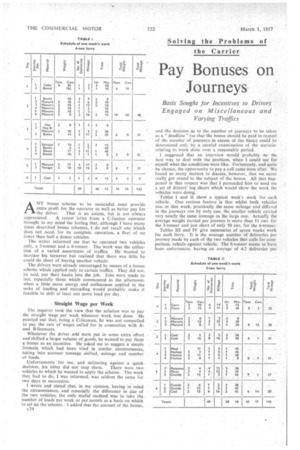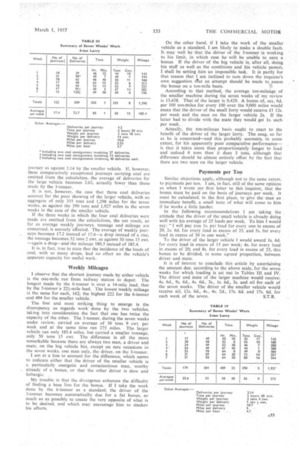Pay Bonuses on Journeys
Page 66

Page 75

If you've noticed an error in this article please click here to report it so we can fix it.
Basis Sought for Incentives to Drivers Engaged on Miscellaneous and Varying Traffics
ANY bonus scheme to be successful must provide extra profit for the operator as well as better pay for
the driver. That is an axiom, but is not always appreciated_ A recent letter from a C-licence operator brought to my mind the feeling that, although I have many times described bonus schemes, I do not recall one which does not need, for its complete operation, a fleet of no fewer than half a dozen vehicles.
The writer informed me that he operated two vehicles only, a 3-tonner and a 6-tonner. The work was the collec tion of a varied assortment of traffics. He wanted to increase his turnover but realized that there was little he could do short of buying another vehicle.
The drivers were already encouraged by means of a bonus scheme which applied only to certain traffics. They did not, he said, put their backs into the job.. Jobs were made to last, especially those which commenced in the afternoon. when a little more energy and enthusiasm applied to the tasks of loading and unloading would probably make it feasible to shift at least one more load per day.
and the decision as to the number of journeys to be taken as a "deadline" (so that the bonus should be paid in respect of the number of journeys in excess of the basic) could be determined only by a careful examination of the statistic, relating to work done over a reasonable period.
I suggested that an interview •would probably be the best way to deal with the problem, when I could see for myself what the conditions were like. Fortunately, and quite by chance, the opportunity to pay a call came soon after. We found so many matters to discuss, however, that we never really got round to the subject of the bonus. All that hap• pcned in that respect was that I persuaded him to send nte a set of drivers' log sheets which would show the work the vehicles were doing.
Tables 1 and II show a typical week's work for each vehicle. One curious feature is that whilst both vehicles ran, in that week, practically the same mileage and differed in the journeys run by only one, the smaller vehicle carried very nearly the same tonnage as the large one. Actually the average weight carried per journey is more than 51 cwt. for the 3-tonner and just short of only 50 cwt. for the 6-tonner.
Tables HI and IV give summaries of seven weeks work for each lorry. It is the average number of deliveries per journey made by each of the two vehicles that calls for comparison. vehicle against vehicle. The 6-tonner seems to haVe been unfortunate, having an average of 4.2 deliveries per Straight Wage per Week
The inquirer took the view that the solution was to pay the straight wage per week whatever work was done. He pointed out that, being a C-licensee, he was not compelled to pay the rate of wages called for in connection with Aand B-licensees.
Whenever the driver arid mate put in some extra effort and shifted a larger volume of goods, he wanted to pay them a bonus as an incentive. He asked me to suggest a simple formula which had been tried in similar circumstances, taking into account tonnage shifted, mileage and number of loads.
Unfortunately for me, and militating against a quick decision, his letter did not stop there. There were two vehicles to which he wanted to apply the scheme. The work they had to do, I was informed, was seldom the same for two days in succession.
I wrote and stated that, in my opinion, having in mind the circumstances, and especially the difference in size of the two vehicles, the only useful method was to lake the number of loads per week or per month as a basis on which to set up the scheme. I added that the amount of the bonus, journey as against 2,14 by the smaller vehicle. If, however, these comparatively exceptional journeys carrying coal are omitted from the calculation, the average of deliveries for the large vehicle becomes 2.02, actually fewer than those made by the 3-wittier.
It is not, however, the case that those coal deliveries account for the poor showing of the larger vehicle, with an aggregate of only 355 tons and 1,298 miles for the seven weeks, as against the 390 tons and 1,927 miles in the seven weeks in the case of the smaller vehicle.
If the three weeks in which the four coal deliveries were made are omitted from the calculations, the net result, so far as average weekly journeys, tonnage and mileage are concerned, is scarcely affected. The average of weekly journeys becomes 17.2 instead of 17.4-a drop instead of a rise; the tonnage becomes 52 tons 2 cwt. as against 50 tons 15 cwt. -again a drop-and the mileage 186.5 instead of 185.4.
It is, in fact, true to state that the incidence of the loads of coal, with so many drops, had no effect on the vehicle's apparent capacity for useful work.
Weekly Mileages
I observe that the shortest journey made by either vehicle is the one-mile run from railway station to depot. The longest made by the 6-tonner is over a 14-mile lead, that by the 3-tonner a 224-mi1e lead. The lowest weekly mileage is the same for each, 142; the highest 222 for the 6-tonner -and 404 for the smaller vehicle.
The first and most striking thing to emerge is the discrepancy as regards workdone by the two vehicles, taking into consideration the fact that one has twice the capacity of the other. The 3-tonner, during the seven weeks under review, carried an average of 56 tons 9 cwt. per week and at the same time ran 275 miles. The larger vehicle ran only 185.4 miles, but carried a smaller tonnage, only 50 tons 15 cwt. The difference is all the more remarkable because there are always two men, a driver and mate, on the big vehicle bin, except on rare occasions in the seven weeks. one man only, the driver, on the 3-tonner.
I am at a loss to account for the difference, which seems to indicate either that the driver of the smaller vehicle is a particularly energetic and conscientious man, worthy already of a bonus, or that the other driver is slow and lethargic. , My trouble is that the divergence enhances the difficulty of finding a base line for the bonus. If I take the work done by the 6-tonner as a standard, the driver of the 3-tonner becomes automatically due for a fat bonus, so much so as possibly to create the very opposite of what is to be desired, and which may encourage him to slacken his efforts. On the other hand, if I take the work of the smaller vehicle as a standard, I am likely to make a double fault. It may well be that the driver of the 3-tonner is working to his limit, in which case he will be unable to earn a bonus. If the driver of the big vehicle is, after all, doing his stuff as well as the conditions and his vehicle permit, I shall be setting him an impossible task. It is partly for that reason that I am inclined to turn down the inquirer's own suggestion teat an attempt should be made to assess the bonus on a ton-mile basis.
According to that method, the average ton-mileage of the smaller machine during the seven weeks of my review is 15,438. That of the larger is 9,429. A bonus of, say, 6d. per 100 ton-thiles for every 100 over the 9,000 miles would mean that the driver of the small lorry would receive El 12s. per week and the man on the larger vehicle 2s. If the latter had to divide with the mate they would get is. each per week..
Actually, the ton-mileage basis ought to react to the benefit of the driver of the larger lorry. The snag, so far as he is concerned-and this probably accounts, to some extent, for his apparently poor comparative performanceis that it takes more than proportionately longer to load and unload 6 tons than it does 3 tons, although that difference should be almost entirely offset by the fact that there are two men on the larger vehicle.
Payments per Ton
Similar objections apply, although not to the same extent, to payments per ton. I am, in fact, still of the same opinion as when I wrote my first letter to this inquirer, that the bonus must be paid on the basis of journeys per week. It must be calculated, in the first place, to give the man an immediate benefit, a small taste of what will come to him if he works a little harder.
In the following recommendations I am taking the attitude that the driver of the small vehicle is already doing well with his average of 25 loads per week. To him I would say: "1 will pay you Is. per load for every one in excess of 20. 2s. 6d. for every load in excess of 25, and 5s. for every load in excess of 30 in one week," To the driver of the larger vehicle I would award Is. 6d. for every load in excess of 15 per week; 4s. for every load in excess of 20; and 8s. for every load in excess of 25, this bonus to be divided, in some agreed proportion, between driver and mate.
It is of interest to conclude this article by ascertaining the amount due, according to the above scale, for the seven weeks for which loading is set out in Tables HI and IV. The driver and mate of the larger machine would receive: 4s. 6d., 9s. 6d., 4s. 6d., 3s., Is. 6d., 3s. and .nil for each of the seven weeks. The driver of the smaller vehicle would receive nil, 12s. 6d., 4s., 4s. 2d., 17s. 6d. and 17s. 6d. for
each week of the seven. S.T.R.












































































































